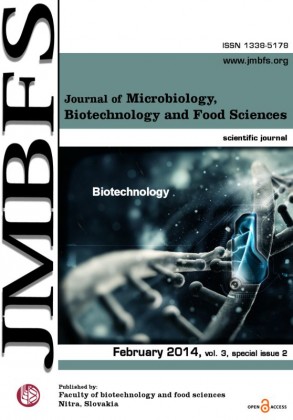PROTEIN COMPLEX OF WHEAT, BUCKWHEAT AND MAIZE IN RELATION TO CELIAC DISEASE
Keywords:
Buckwheat, celiac disease, maize, proteins, wheatAbstract
Cereals are the most wide spread and very important plants utilized as a food source for mankind and for animals where they play role in energetical metabolism and proteosynthesis. Cereals contain proteins with unique properties. These properties allow us to produce leavened bread. Technological characteristic of cereal grain is determined by quantity and quality of storage proteins which represent alcohol soluble prolamins and glutenins soluble in acids and basis solutions. Celiac disease is one of the most frequent food intolerance caused by cereal storage proteins. Therapy consists of strict diet without consumptions of cereals or gluten. Pseudocereals are very perspective groups of plants in gluten free diet, due to absence of celiac active proteins, but on the other hand, flour from pseudocereals is not very suitable for baking. There are a lot of analytical methods applicable for detection of celiac active proteins in cereal and pseudocereal grain. Electrophoretical and immunochemical methods are the most utilized. Genotypes of wheat and maize were homogeneous and singlelined in contrast with genotypes of buckwheat. Average content of HMW-GS was highest in genotypes of bread wheat and lowest in buckwheat varieties. A celiac active fraction of storage proteins (LMW-GS and gliadins) was detected at the highest content level in wheat genotypes. Genotypes of buckwheat and maize showed similar low content of this protein fraction. Presence of residual albumins and globulins in buckwheat varieties showed the highest value.Downloads
Download data is not yet available.
Downloads
Published
2014-02-01
How to Cite
Chňapek, M., Tomka, M., Gregáňová, ŽelmÃÂra, & Gálová, Z. (2014). PROTEIN COMPLEX OF WHEAT, BUCKWHEAT AND MAIZE IN RELATION TO CELIAC DISEASE. Journal of Microbiology, Biotechnology and Food Sciences, 3(special issue 2 (Biotechnology), 88–92. Retrieved from https://office2.jmbfs.org/index.php/JMBFS/article/view/7630
Issue
Section
Biotechnology
License
Copyright (c) 2014 Milan Chňapek, Marián Tomka, ŽelmÃÂra Gregáňová, Zdenka Gálová

This work is licensed under a Creative Commons Attribution 4.0 International License.
All papers published in the Journal of Microbiology, Biotechnology and Food Sciences are published under a CC-BY licence (CC-BY 4.0). Published materials can be shared (copy and redistribute the material in any medium or format) and adapted (remix, transform, and build upon the material for any purpose, even commercially) with specifying the author(s).

